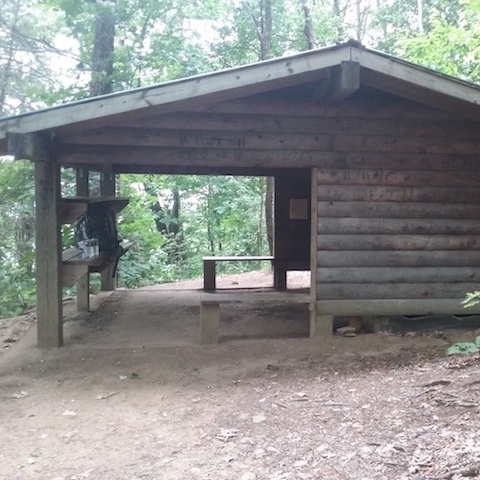AT Lesson #2: Not Making a Decision is a Decision


One of over 250 backcountry shelters located along the AT. I frequently hung my hammock near these structures during my trip.
Tall trees reached heavenward and poison ivy blanketed the ground around me like an itchy green photosynthesizing snow except for in this small patch of well worn earth directly in front of me. It looked as if a multitude of hikers had camped here over the years. I scanned the area looking for the next blaze. Something across the clearing caught my eye: a sign. Hawk Mountain Shelter was 0.2 miles down a blue blazed trail west of where I stood. I had accomplished my goal for the day.
It was 4:00 p.m. I had begun my day on the Appalachian Trail just five hours earlier. I had walked 8 miles, not counting the mile I had hiked to get to the trailhead. I had intentionally scheduled an easy first day on the AT. I had climbed around 1,000 feet and descended approximately the same, a very light day by AT standards. I was tired, but still felt good, especially considering my pack was laden with seven days of food.
Approaching the shelter, I heard a voice. I wasn’t the first to arrive at Hawk Mountain. A woman was lying on the shelter floor, not moving, not talking. Her companion was setting up a tent nearby.
Not wanting to alarm anyone, I called out “Hello” as I came into sight. The woman stopped setting up her tent and greeted me. We talked for a few minutes and she directed me toward the stream that ran another tenth of a mile beyond the shelter. The other woman still hadn’t moved or spoken. Warily, I tried to steal a glance in her direction to see if she was still breathing. I couldn’t tell.
When I returned from filling my water bottles, I was relieved to see both women sitting at the picnic table. With a groan that surprised me, I slid my pack off and joined them at the table. We talked and asked each other the questions that would become common conversations on the trail. Where do you call home? Where did you start the day? How long are you going to be on the trail? Have you heard anything interesting from south bounders about the trail ahead?
Retrieving some dehydrated cherries from my pack, I popped a couple into my mouth. The sugary sweet fruit buoyed my spirits and gave me some much needed energy.
There was still four hours until the sun would set and I considered hiking a little further. I mentally made a pros and cons list. On the pro side: there was plenty of daylight left, physically and mentally I felt better than I had expected, and I could get ahead of my schedule. On the downside, the next campsite listed in my guidebook was over six miles away and there was no guarantee that I’d find water. Additionally, I didn’t want the trip to become a chore. I wanted to enjoy my time in the woods. I weighed these factors as I talked with the ladies.
The ladies were from Florida, one a school teacher and the other a retired Army officer. As we talked, another lone hiker strolled into the shelter area. He dropped his pack, filled his water bottles in the nearby stream, and then headed out again. I gave fleeting thought joining him, but something about his demeanor was uninviting. I didn’t know it at the time, but I would meet him again and he would earn the trail name Frankenshoe.
The next 90 minutes seemed to fly by as I chatted with my fellow hikers, rested my feet, and snacked on trail food. I was still considering walking a little further down the trail before setting up camp for the night, but the inertia of sitting at the table enjoying the conversation was powerful.
My decision was further postponed when the Virginians dragged into camp. The husband and wife duo abandoned their packs where the stood and flopped down at the other end of the picnic table, obviously exhausted. I offered them some of my dried cherries, but they declined.
Another 30 minutes passed; it was now 6:00 p.m. With only a couple of hours of daylight left, the sun was rapidly setting on my options. A few more backpackers came into camp and claimed tent sites. Finally, I decided to do the same. Rummaging in my backpack for my hammock and tarp, I claimed a campsite near the shelter. I called Hawk Mountain home for the night.
AT Lesson: Not Making a Decision is a Decision
When a timeline for a making a decision is not clearly defined, it’s easy to fall victim to one of the oldest enemies of decision-making: paralysis by analysis. We can overthink a decision and in the process, postpone acting at all. Counterintuitively, our inaction actually becomes a decision and, in effect, an action.
Set a hard deadline for making a decision. Seldom is anything gained by waiting. Developing a bias toward action will help you and your team to become intentional and more productive.


Recent Comments